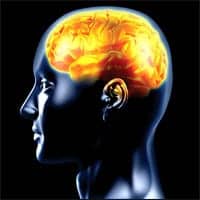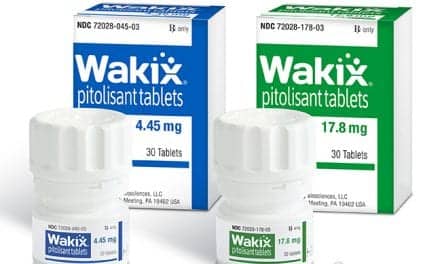| Injuries and diseases that harm the brain also frequently trigger sleep disorders that hinder recovery. |
By Regina Patrick, RPSGT
Insomnia, hypersomnia, sleep-disordered breathing (SDB), circadian rhythm disorders, periodic limb movement (PLM) disorder, and narcolepsy are sleep problems that can develop after the brain has been injured by trauma or disease. Sleep disorders can have negative consequences on rehabilitation efforts of a person with brain injury since symptoms, such as excessive sleepiness, can worsen problems (eg, distractibility, immobility, forgetfulness, etc) associated with the brain injury. Recognizing and treating sleep disorders could therefore improve recovery in people with brain injury. However, when symptoms such as sleepiness or insomnia are noted, they are often viewed as just a natural consequence of brain injury and not treated effectively.
Brain injury can be acquired or be the result of disease. A traumatic brain injury (TBI) is one type of acquired brain injury—that is, an injury that occurs after birth. TBI occurs when external factors result in bleeding (ie, trauma) in the brain. The trauma may be induced by an object that penetrates the skull (ie, penetrating wound or open-head injury) or by a force, such as whiplash, that does not penetrate the skull (ie, nonpenetrating wound or closed-head injury), but nevertheless causes brain tissue to twist or shear.
A second type of acquired brain injury is nontraumatic brain injury. This type of injury results from internal factors that disrupt the biochemical processes in the brain, thereby leading to tissue damage. Factors that can cause nontraumatic damage to the brain are infection, alcoholism/drug use, anoxia (lack of oxygen), metabolic disorders (eg, hepatitis), stroke, and tumors.
| SearchSleep Review’s online archives for more information on sleep and brain injuries. |
A third type of brain injury that is not usually classified as acquired is neurodegenerative diseases, such as Alzheimer’s disease, Parkinson’s disease, multiple sclerosis, and Huntington’s chorea. Neurodegenerative diseases slowly destroy neurons, thereby disrupting transmission of signals. Depending on which area of the brain is most affected by the disease, a person may have problems with dementia, mobility, memory, or other cognitive functions as the disease progresses.
About 50% 1 of people who have TBI complain of sleep problems after their injuries. The prevalence of sleep problems is also higher than normal in people with nontraumatic brain injury and neurodegenerative diseases. 2,3 The most common complaints are difficulty initiating or maintaining sleep (ie, insomnia) and excessive daytime sleepiness (EDS). Less frequently reported are symptoms of circadian rhythm disorders, narcolepsy, and SDB.
BRAIN DISORDERS AND SLEEP
Sleep complaints that develop after brain injury may be related to damage that has occurred to the medulla or brain structures that play a role in sleep, such as the reticular formation and the suprachiasmatic nucleus (SCN). For example, damage to the respiratory center in the medulla can alter respiration and result in SDB. Damage to the reticular formation—a network of neurons spread centrally throughout the brainstem that play a role in wakefulness and rapid eye movement (REM) sleep—can lead to problems with initiating and maintaining sleep, resulting in insomnia, or lead to problems with the onset of REM sleep, resulting in narcolepsy. Damage to the SCN—a group of neurons in the anterior lobe of the hypothalamus that set the pace of one’s circadian rhythm—can result in circadian rhythm problems, such as a delayed or advanced sleep phase or a non-24-hour rhythm.
Some scientists believe that the high prevalence of sleep disorders after brain injury may be unrelated to the injuries, and instead may reflect a high prevalence of undiagnosed preexisting sleep disorders. Sleep researchers Richard J. Castriotta and associate Jenny M. Lai 4 investigated the prevalence of sleep disorders in TBI subjects who all had EDS and found that three of their 10 subjects had had symptoms indicative of a sleep disorder before the trauma. (One of the three had had symptoms of upper airway resistance syndrome [UARS]; the second, narcolepsy; and the third, OSA.) However, none had been diagnosed until Castriotta’s study. Two of the three had suffered their trauma while driving, and Castriotta and Lai speculated that the subjects’ undiagnosed sleep disorders may have resulted in sleepiness that in turn may have played a role in their accidents. As further support for this speculation, they pointed out that people with OSA are six to seven times more likely to have a motor vehicle accident and 25% of narcoleptics have had a sleep-related motor vehicle accident.
Good et al 5 reported the case of a patient who, after TBI, developed the classic tetrad (four symptoms) of narcolepsy: cataplexy, EDS, sleep paralysis, and hypnagogic hallucinations. They did tissue typing and found that the patient had the genetic marker (HLA-DR2) for narcolepsy. They believe that the interaction of the brain injury with the genetic predisposition created the conditions needed to allow narcolepsy to manifest.
A person who, after brain injury, develops SDB, periodic limb movements, or narcolepsy may complain of problems with EDS since these disorders result in frequent nocturnal arousals. In circadian rhythm disorders (eg, advanced or delayed sleep phase syndrome, non-24-hour rhythm), a person may complain of struggles with either EDS, insomnia, or alternation of these as their rhythm transiently falls in and out of phase with the societal norm. Based on these complaints and believing them to be a consequence of the brain injury, a physician may simply prescribe stimulants for excessive sleepiness or hypnotics for insomnia.
Some researchers, however, have had positive results in improving sleep in people with brain injury when an underlying sleep disorder was more directly addressed. Castriotta and Lai 4 used CPAP to treat seven of their 10 subjects who had SDB. The subjects later reported that CPAP treatment had improved their quality of life. Dutch researchers J. Elsbeth Nagtegaal et al 6 successfully used melatonin to restore a normal circadian rhythm in a teenage female patient who developed delayed sleep phase syndrome after her TBI. Before treatment, her sleep-wake phases were delayed by almost a half day.
Canadian researchers Marie-Christine Ouellet and Charles M. Morin 7 used cognitive therapy to reduce symptoms of insomnia in a male subject who had suffered a TBI. Before treatment, the subject took about 47 minutes to go to sleep. This fell to 18 minutes after eight sessions of cognitive therapy. Other beneficial effects of cognitive therapy were that the subject’s sleep efficiency improved (rising from 58% to 83%); total time awake during a sleep period decreased (falling from 63% to 26%); and awakenings fell (from 21 awakenings to eight awakenings). Priano et al 8 note that transdermal administration of some dopaminergic drugs (eg, rotigotine [Neupro]) has been beneficial in reducing symptoms of PLM or RLS, thereby improving sleep in people with neurodegenerative diseases such as Parkinson’s disease.
Most people with brain injury who struggle with sleepiness or insomnia are not evaluated for a sleep disorder. Castriotta and Lai 4 point out that had it not been for their study, the subjects would not have known that they had easily treatable sleep disorders. Yet, after treatment of the disorders, the subjects felt that their quality of life quickly improved. Such findings point to the importance of determining whether struggles with excessive sleepiness or insomnia in a person with brain injury are due to the injury or because of a sleep disorder.
Regina Patrick, RPSGT, is a contributing writer for Sleep Review.
References
- Parcell DL, Ponsford JL, Rajaratnam SM, Redman JR. Self-reported changes to nighttime sleep after traumatic brain injury. Arch Phys Med Rehabil. 2006;87:278-285.
- Rubinstein ML, Selwyn PA. High prevalence of insomnia in an outpatient population with HIV infection. J Acquir Immune Defic Syndr Hum Retrovirol. 1998;19:260-265.
- Brotini S, Gigli GL. Epidemiology and clinical features of sleep disorders in extrapyramidal disease. Sleep Med. 2004;5:169-179.
- Castriotta RJ, Lai JM. Sleep disorders associated with traumatic brain injury. Arch Phys Med Rehabil. 2001;82:1403-1406.
- Good JL, Barry E, Fishman PS. Post-traumatic narcolepsy: the complete syndrome with tissue typing. Case report. J Neurosurg. 1989;71:765-767.
- Nagtegaal JE, Kerkhof GA, Smits MG, Swart AC, van der Meer YG. Traumatic brain injury-associated delayed sleep phase syndrome. Funct Neurol. 1997;12:345-348.
- Ouellet MC, Morin CM. Cognitive behavioral therapy for insomnia associated with traumatic brain injury: a single-case study. Arch Phys Med Rehabil. 2004;85:1298-1302.
- Priano L, Gasco MR, Mauro A. Transdermal treatment options for neurological disorders: impact on the elderly. Drugs Aging. 2006;23(5):357-375.




